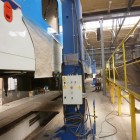LIFTING JACKS
Lifting Jack Types
The company manufactures a series of basic lifting jack types the parameters and equipment of which can be adapted if necessary depending on specific needs of the customer. The basic lifting jack types include but are not limited to the following:
PZK 4 IT
A set of 4 lifting jacks PZK 4 IT is designated for the lifting of buses up to 16 tonnes on their production line. The supporting arm is retractable and it is completed with rotary forks used to lift vehicle being fixed using its wheels. Fixed driving wheels for the travel of unloaded lifting jack along the bus. The lifting jack is anchored to the ground when in its working position.
PZK 6,5
Set of 4 lifting jacks designated for lifting of tramway housing up to 26 tonnes. The supporting arm is retractable. Mechanically lifted driving wheels support unloaded lifting jack travel along the rail. The lifting jack is anchored to the ground when in its working position.
UZZC 7.1 (7.2)
Set of 4 lifting jacks (it may be composed of 6, 8 and 12 lifting jacks, too) is designated for the lifting of railway vehicles up to 28 tonnes. The supporting element is exchangeable (the railway vehicle lifting arm may be replaced by frame or form for road vehicle lifting with such vehicles being fixed using their wheels). Hydraulically lifted driving wheels for unloaded lifting jack travel (the type UZZC 7.2 has fixed front wheels and slide in shafts).
PZ 10 CH
A set of 4 lifting jacks is designated for the lifting of railway vehicle housing up to 40 tonnes. The supporting arm is retractable. Hydraulically lifted driving wheels support unloaded lifting jack travel.
PZ 10
A set of 4 lifting jacks is designated for the lifting of railway vehicle housing (in particular railway carriages) up to 40 tonnes. The supporting arm is retractable. Hydraulically lifted driving wheels support unloaded lifting jack travel.
ST 12 ZT
A set of 4 lifting jacks is designated for the lifting of railway vehicle housing up to 48 tonnes. The supporting arm is retractable. Hydraulically lifted driving wheels support unloaded lifting jack travel.
PZ 12 VM
A set of 8 lifting jacks (only one foursome maybe used) is designated to lift railway vehicle housing up to 96 tonnes. The supporting arm is retractable. Hydraulically lifted driving wheels support unloaded lifting jack travel.
ST 12
A set of 4 lifting jacks designated for the lifting of railway vehicle housing up to 48 tonnes. The supporting arm is fixed. Hydraulically lifted driving wheels support unloaded lifting jack travel.
PZ 16 CH
A set of 4 lifting jacks is designated for the lifting of railway vehicle housing up to 64 tonnes. The supporting arm is retractable. Hydraulically lifted driving wheels support unloaded lifting jack travel.
PZ 25
A set of 4 lifting jacks designated for lifting of railway vehicles (in particular locomotives) up to 100 tonnes. The supporting arm is retractable. Mechanically lifted driving wheels support unloaded lifting jack travel.
Version
Lifting jacks are manufactured in a mobile version for transfer on solid floor or on rails or with fixed anchoring. The lifting jacks are designed for the application in both interior and exterior environment or, as the case may be, for explosive environment applications. Each column can be controlled separately or together with others from a central control panel. /p>
Lifting jacks are designated for the lifting of road and railway vehicles or, as the case may be, for the lifting of various technological systems (ceramic product firing kilns and the like).
All types are based on similar design and electro-mechanic principle of their drive. This technology is principally more robust, safer and durable compared to units with hydraulic drives.
The lifting jack consists of the following main components: stand, carriage, supporting arm, driving system and distribution unit. Supporting structures are welded of steel sheets and profiles. The electric motor makes the supporting screw rotate by means of gears. A supporting nut on the screw lifts the carriage that moves on the stand on pulleys. The carriage is equipped with a supporting arm with a support that supports the burden at points of support, extreme positions of the lift are limited by end switches.
Safety
The most important and most stable safety element of our lifting jacks is the self-locking function of their motion system that is composed of a braked electric motor, gear box, supporting screw and supporting nut. Other safety elements include unloaded safety nut, emergency end switches and, as the case may be, other items depending on the version of the lifting jack (protection against obstacle impact, lifting synchronisation etc.).
Our lifting jacks are characterised in particular by robustness, long service life and safety.
FEREX Machinery s.r.o. engineering production:
LIFTING JACKS | LIFTING PLATFORMS | POSITIONING SYSTEMS | WINCHES | CRANES | OTHER




























